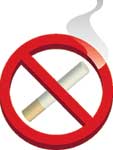
Study shows law prompts drop in heart attacksALBANY, N.Y. (AP) - A study released Thursday credits New York's 2003 Clean Indoor Air Act with an 8 percent drop in heart attacks statewide because of reduced exposure to second-hand smoke. The report, issued by the state Health Department, found that hospitals admitted 3,813 fewer patients for heart attacks in 2004 than would be expected in New York without the indoor smoking ban. Studies elsewhere have reached similar conclusions. In one case, the rate of admissions for heart attacks returned to normal after the ban was lifted.
Admissions for strokes associated with the smoking ban remained unchanged in New York, according to the report, which was published in The American Journal of Public Health."The scale of our study is much larger than any study done before," said Harlan Juster, who led the study and works for the state Health Department. "Where they looked at a few hospitals, we looked at all hospitals in New York state that are required to report." The study examined results from every hospital in the state except those that are federally run. It also tracked other variables that contributed to reducing heart attacks and isolated results related to secondhand smoke. The total decrease in heart attacks was greater than 8 percent. Researchers said that number unavailable Thursday. Previous studies reported more dramatic results, including a 2003 study in Helena, Mont., that found heart attacks fell by about 40 percent after voters passed an indoor smoking ban. The rates returned to normal when the ban was lifted. Another study found heart attack rates in Pueblo, Colo., dropped by 27 percent in the 18 months after a smoking ban was imposed in bars, restaurants and other public places. Michael Seigel, a professor at Boston University's Social And Behavioral Sciences Department who reviews tobacco policies for the school, including smoking bans, questioned the conclusions of the New York study based on its limited scope."You can't conclude that the decline was due to the smoking ban," said Siegel, who has testified in New York City, Connecticut and Massachusetts about the value of indoor smoking bans. "Because it's possible that decline was happening everywhere, and without assessing data from every state, there's no way to know." The New York study examined information from a 10-year span starting before the statewide smoking ban took effect. Researchers found that regulations by local governments that preceded the statewide ban also contributed to a downward trend for heart attacks."The moderate laws that were done in many counties did have an impact on reducing emissions and did protect people from secondhand smoke," Juster said. "This reports speaks to the importance of having a comprehensive statewide ban on indoor smoking." "Science is not supposed to root for a particular outcome," said Audrey Silk, of New York City Citizens Lobbying Against Smoker Harassment. "It's to study and dispassionately report the results. These are advocates first and scientists second." Juster said the study was unbiased. "Clearly I'm a researcher, but I'm also probably a tobacco control advocate," Juster said. "But I'm a researcher first. If the (clean air) law was not effective I would be reporting that, but the law is effective." The U.S. Surgeon General reported last year that nonsmokers exposed to secondhand smoke increase their risk of developing heart disease and lung cancer by up to 30 percent. At least 22 states and the District of Columbia have enacted measures requiring all workplaces, including restaurants and bars, to be smoke-free, according to the National Conference of State Legislatures. |
|| Front
Page | News | Editorial | Columns | Sports | Plus | Financial
Times | International | Mirror | TV
Times | Funday
Times || |
| |
Reproduction of articles permitted when used without any alterations to contents and the source. |
© Copyright
2007 Wijeya
Newspapers Ltd.Colombo. Sri Lanka. All Rights Reserved. |
